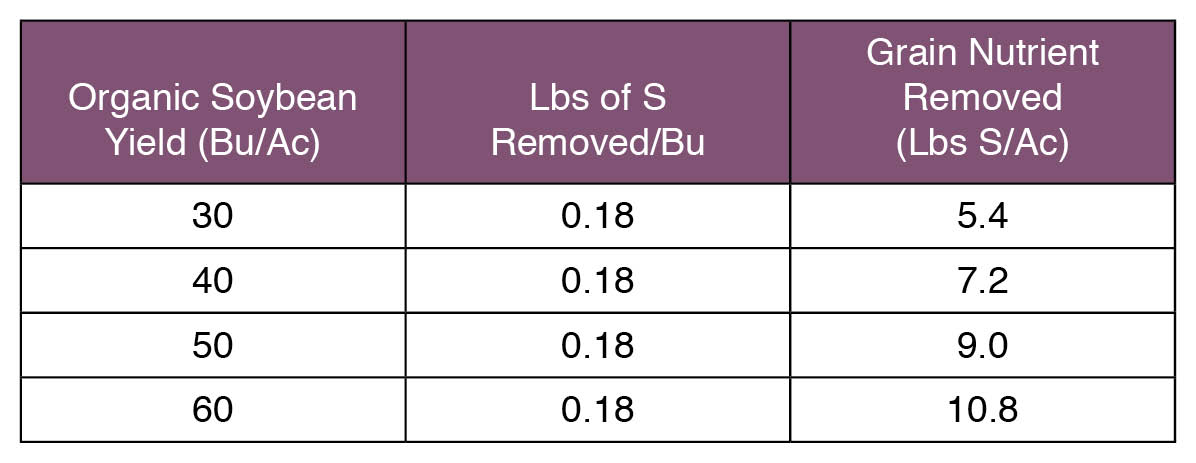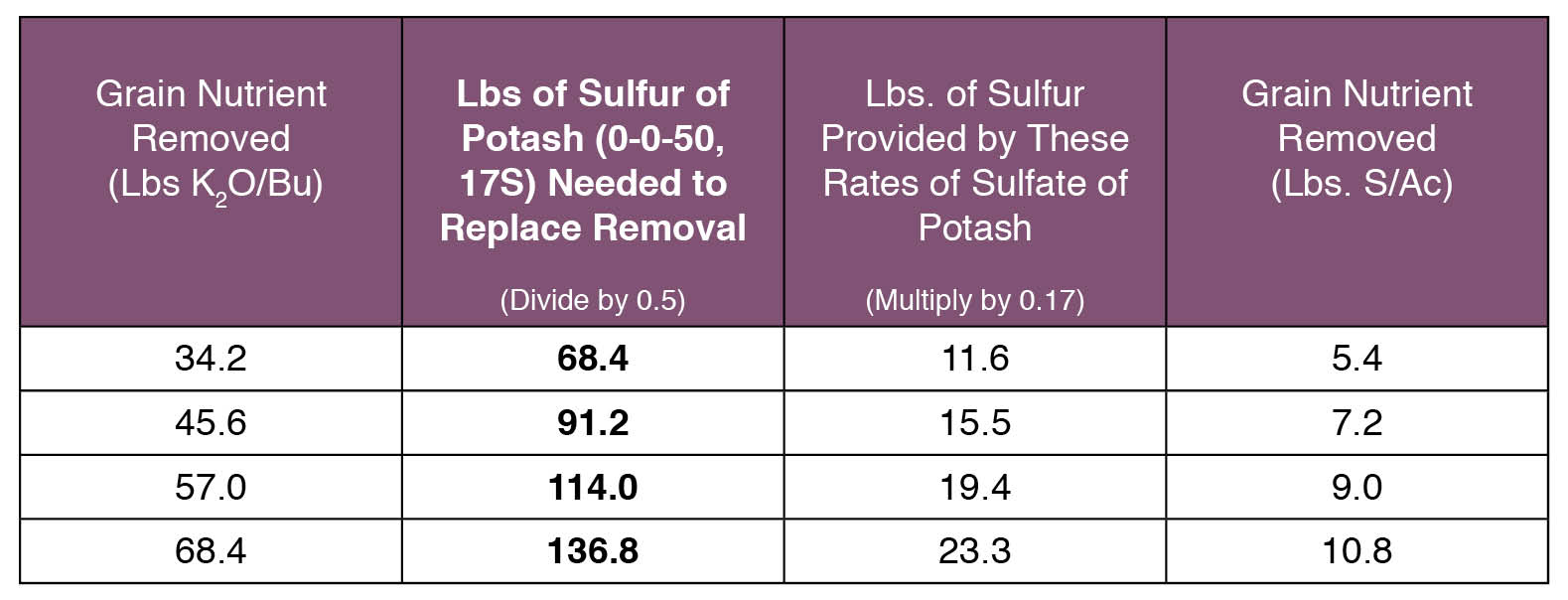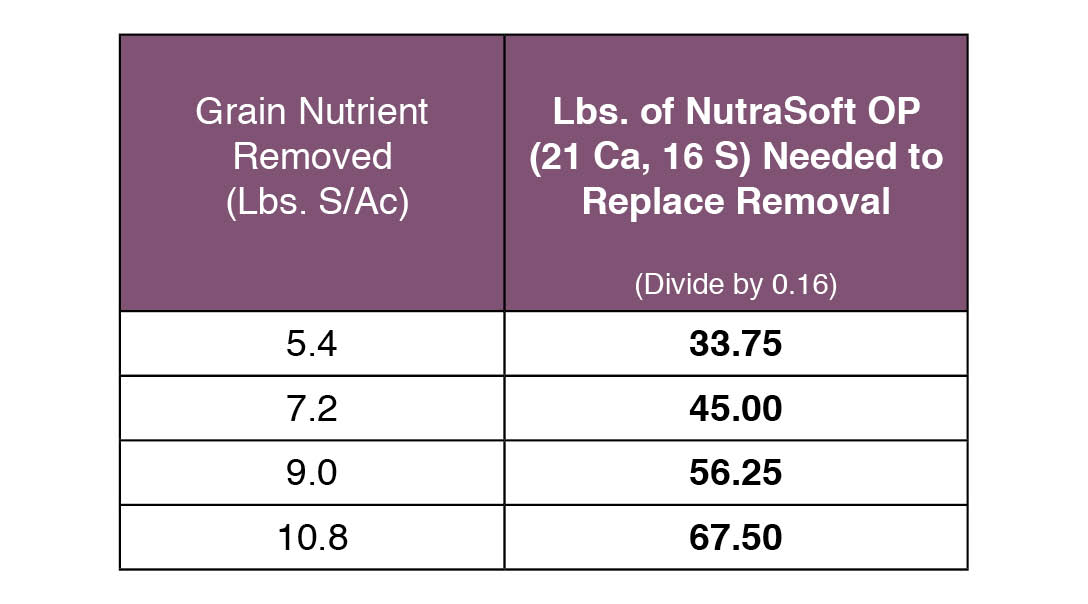
Organics: Season-End Fertilizer Considerations, Potassium and Sulfur
In reviewing fall soil samples, I have noticed two nutrients needing more attention on organic farms: potassium (K) and sulfur (S). Ahead of an organic corn rotation, these nutrients are often overlooked due to the priority of providing enough nitrogen (N). For soybeans, these nutrients are even more important, as soybeans use more pounds of potassium and sulfur per bushel of grain than corn. As we approach the 2020 growing season, predictions show more organic corn acres will be planted due to the tumultuous challenges of 2019. According to Mercaris’ recently published “Organic Commodity Outlook” the excessive moisture and delayed planting dates pushed many organic farmers to switch from corn to beans, especially in Michigan, Ohio, Minnesota, and Wisconsin. With this in mind, let’s review a three-step process of how an organic farmer can approach replacing potassium and sulfur after a soybean crop that is rotating into 2020 corn production.
Step 1:
Start with reviewing the “Grain Nutrient Removal Rates” (Figure 1) that are a part of the recently revised “Tri-State Recommendations” published by The Ohio State University.

Figure 1: Grain Nutrient Removal Rates for corn, soybeans, and wheat were recently revised by “Tri-State Recommendations” and published by The Ohio State University. Source: “Nutrients Removed with Harvested Corn, Soybean, and Wheat Grain in Ohio”, The Ohio State University, 2019.
If dealers and growers in the Eastern Corn Belt have not yet heard, the Tri-State Recommendations decreased nutrient removal rates for P and K from 1995 levels (Figure 2).

Figure 2: New data from “Tri-State Recommendations” shows phosphorus and potassium grain removal rates are lower compared to 1995 for corn, soybeans, and wheat. Source: “Nutrients Removed with Harvested Corn, Soybean, and Wheat Grain in Ohio”, The Ohio State University, 2019.
This is incredibly valuable information that can help save money for both conventional and organic farmers. Today’s genetics of crop varieties have become more efficient since 1995. As a result, the industry does not need to waste precious input dollars on over-application of nutrients the crop will not be able to utilize and that would otherwise wash away (phosphorus) or become locked up in the soil profile (potassium).
Step 2:
Calculate the pounds of potassium and sulfur used by the 2019 organic soybean crop per the Nutrient Removal Rates. This equals the pounds of nutrients considered lost from the soil profile because they were taken up by the crop. Therefore, it needs to be replaced by amendments such as manure, cover crops, or organic-approved fertilizers. See examples 1 and 2 below. While the testing for the revised Tri-State Recommendations occurred on conventional farms, these rates still provide a useful estimate for organic grain growers. The difference between genetics available to conventional and organic farmers warrants that research eventually be performed on organic farms to understand if removal rates vary between production systems.
Example 1: Potassium Removal of Organic Soybeans (ahead of organic corn)

Example 2: Sulfur Removal of Organic Soybeans (ahead of organic corn)

Step 3:
Choose your organic-approved amendment and calculate the pounds of product that need to be applied to replace the nutrients from the soybean crop. Below are calculation examples of two commonly used organic-approved nutrients, sulfate of potash (0-0-50, 17S) and NutraSoft® OP (pelletized gypsum, 21 Ca, 16 S). These two products provide potassium and sulfur to organic crops.
Example 1: Replacing Potassium and Sulfur with Sulfate of Potash (after soybeans into corn)

Doing the math long-hand proves out my standard recommendation for organic farmers: approximately 100 lbs of organic sulfate of potash (SOP) after beans and ahead of corn, if soybean yields average between 40-60 bu/ac. If a farmer is on the lower range of yield, then the application rate will be lower. Soil testing values should also be taken into consideration. I prefer to use Percent Base Saturation for measuring potassium and recommend growers work to keep K within 3-5 % of total base saturation. The reason for utilizing Percent Base Saturation over soil nutrient levels is the emphasis on overall balancing of nutrients within the soil profile; in other words, balancing potassium with the other cations (calcium, magnesium, and sodium.)
In addition, one will notice these rates for SOP (second to left column) provide more sulfur than would be required to replace nutrient removal (far right column). I am ok with applying additional sulfur for two reasons: (1) My common recommendation is 20 lbs of sulfur on every acre each year (both conventional and organic farms) because most soil test reports are low, and (2) sulfur is essential to build complete proteins in the grain, along with its contributions to fight pests. If a plant is building complete proteins, several insects and diseases will not be able to penetrate the outer surface of the leaf tissue; thereby preventing infestation or inoculation.
The next example is more straight-forward than the sulphate of potash example because NutraSoft OP pelletized gypsum only supplies sulfur, and no potassium. Throughout The Andersons’ service area, organic farmers claim rewarding benefits of using our pelletized gypsum in their farming operations due to its additional soil health effects in improving tilth, water infiltration, and aeration of soils. This is largely credited to the dual action of calcium and sulfur to balance cations within the soil profile and help to loosen tight soils often caused by excessive magnesium.
Example 2: Replacing Sulfur with NutraSoft OP (after soybeans into corn)

For more information about how to buy organic sulphate of potash or NutraSoft OP pelletized gypsum, please contact your Territory Manager. You may also reach us directly at png@andersonsinc.com.
View our complete organic product listing with labels, product sheets, and safety data sheets (SDS) on our website.
Where to find The Andersons Organics in the next 30 days!
Our organics team looks forward to visiting with you at the following events over the next month:
2019 Acres Eco-Ag Conference and Trade Show in Minneapolis, MN; December 9-12, 2019. Visit https://events.acresusa.com to learn more and register.
2019 National No-Tillage Conference in St. Louis, MO; January 7-10, 2020. Dani Kusner, The Andersons Organic Agronomist, will be speaking on “Microbial Nutrient Cycling and Minimizing Tillage in Organic Systems,” on Wednesday, January 8, from 10:35-11:35 am. Visit https://www.no-tillfamer.com/nntc to learn more and register.
